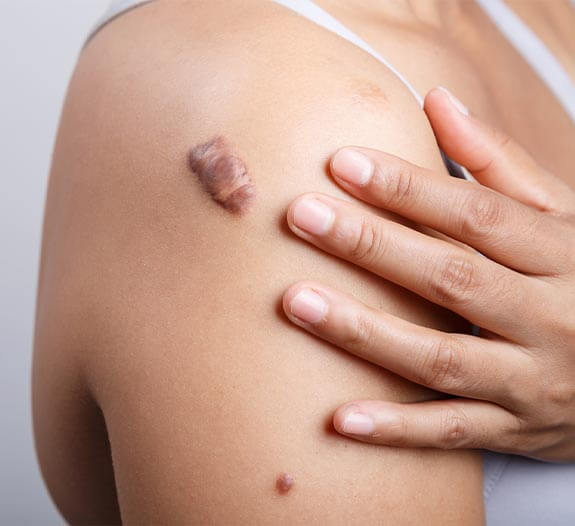
Keloids Treatments
There are various treatment options available for keloids, however, no treatment for keloids is considered to be 100% effective. The most common treatments are:
1. Silicon sheets
This is a clinically proven and drug-free treatment option for keloids. Silicone sheeting is safe and effective to reduce existing scars and helping to prevent new scars in patients age 3 years and above. Nowadays, silicon is also available in a gel formulation, which is easy for application. Other options for keloid treatment can be creams or gels that contain onion extract with allantoin which are available over the counter. These applications prevent and reduce keloid scars and hypertrophic scars and can be used in the treatment of all post-traumatic scars (like burns, acne, piercings) or post-surgery. This treatment is simple but requires persistence.
2. Steroid injections
Steroid injections are best used when the scar begins to thicken or in a person who is a known keloid former. A series of at least 3-4 injections with triamcinolone acetonide (40mg/ml) is given every 4 weeks. The fibrosis reduces in the form of softness or reduction of size and flattening of the lesions.
3. Uses of Injectable toxins
Newer recent International studies have documented that, if peri-lesional injectable toxins are given at the same time of injecting steroids, there is a faster improvement and sustained result in the case of keloids.
4. Cryosurgery
Cryosurgery is a good treatment option for keloids which are small in size. It is often combined with monthly cortisone injections. Cryosurgery freezes the skin and effectively creates an area of localized frostbite. There will be a slough of skin and keloid with the renewed skin surface.
5. Compression on Keloids
Compression garments applied to the affected site over several weeks to months and silicone scar sheets may be used safely under compression garments that may lead to a reduction in the size and flattening of the keloid.
6. Surgery
Surgery will require great care during and after the operation because keloids that reoccur after being excised may become larger than the original. In around 50% of cases, there are chances of recurrence after surgical removal. However, if we are doing surgical or laser excision followed by intralesional injections of a corticosteroid and/or coverage with a silicone scar sheet then chances of recurrence are very less.
7. Laser Therapy
This procedure is an alternative to conventional surgery for keloid removal. In this, a relatively new approach is to combine laser therapy with steroid injections and the use of Silicone Sheeting.
8. Newer Treatments
Many clinical studies show that few drugs like interferons and certain antimitotic drugs can be used in keloid. However, further studies and evaluations are needed to determine the exact benefits of this treatment technique.
 Whatsapp
Whatsapp Facebook
Facebook Twitter
Twitter Instagram
Instagram Linkedin
Linkedin Pinterest
Pinterest